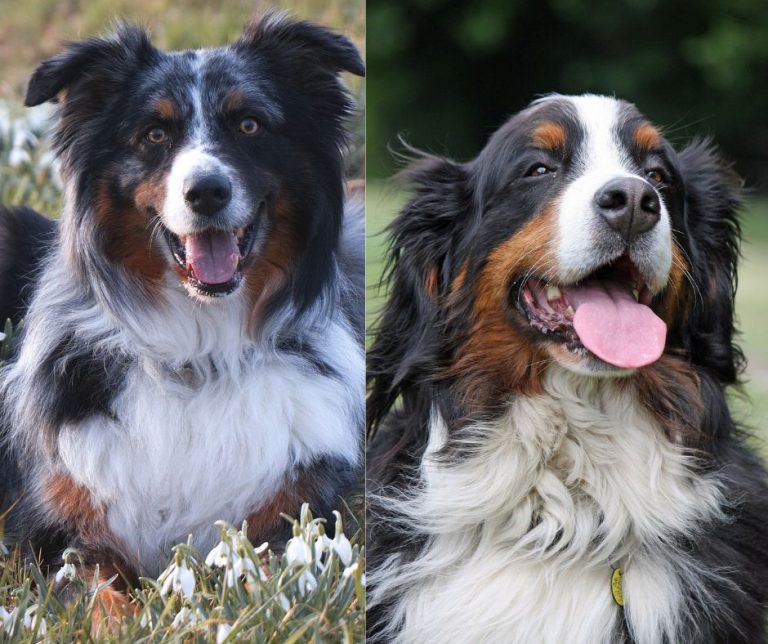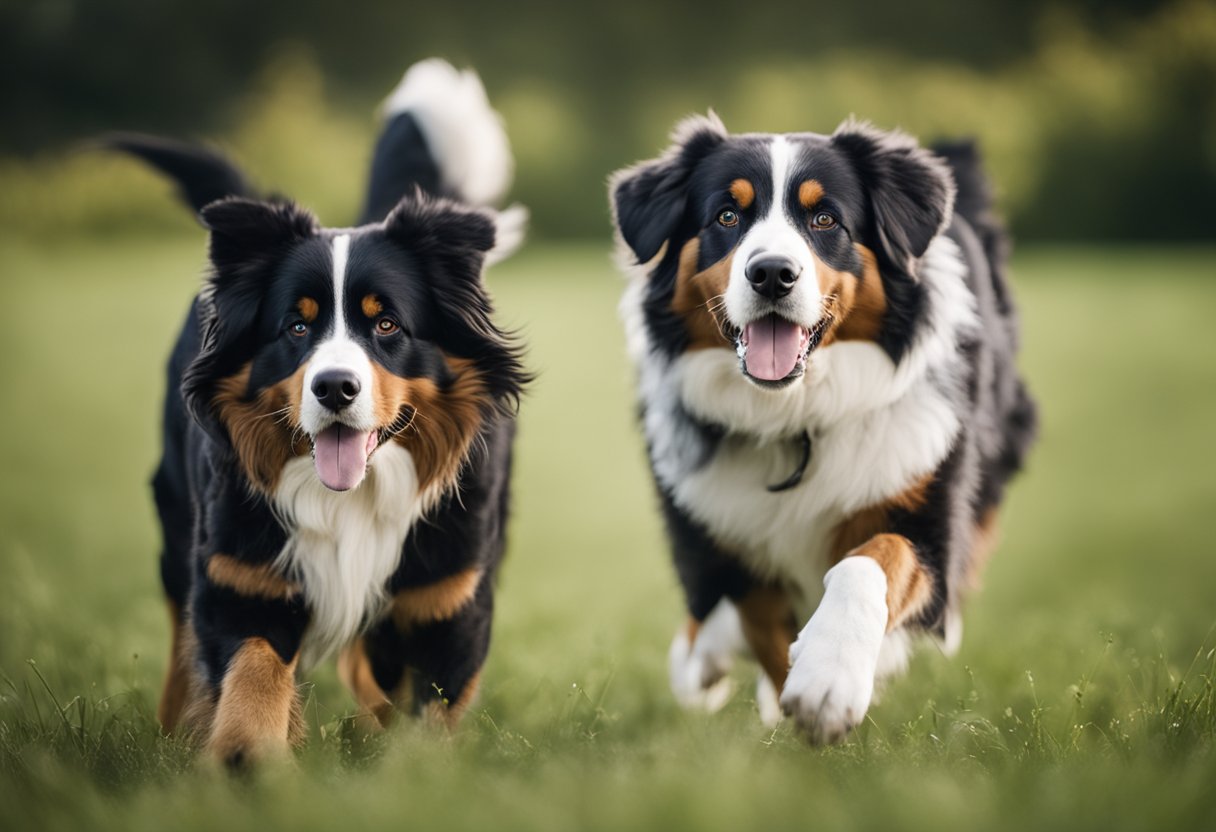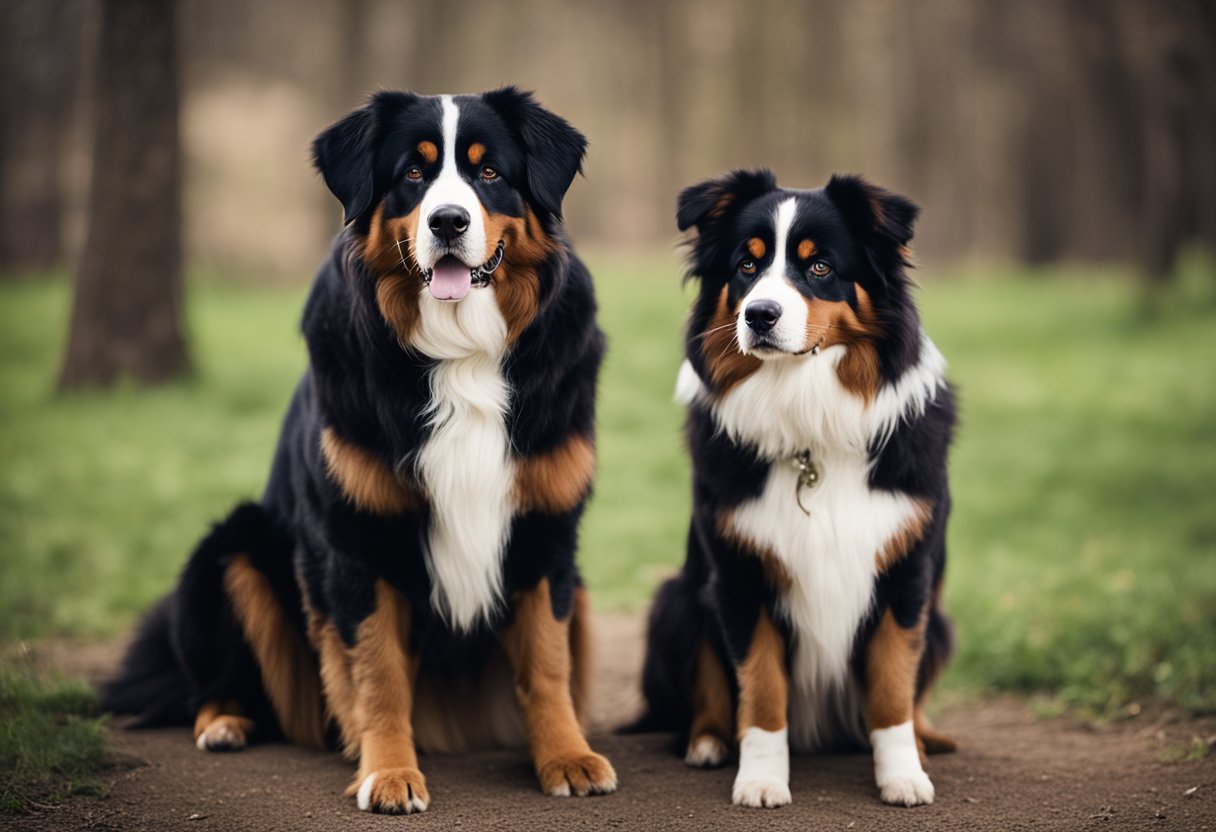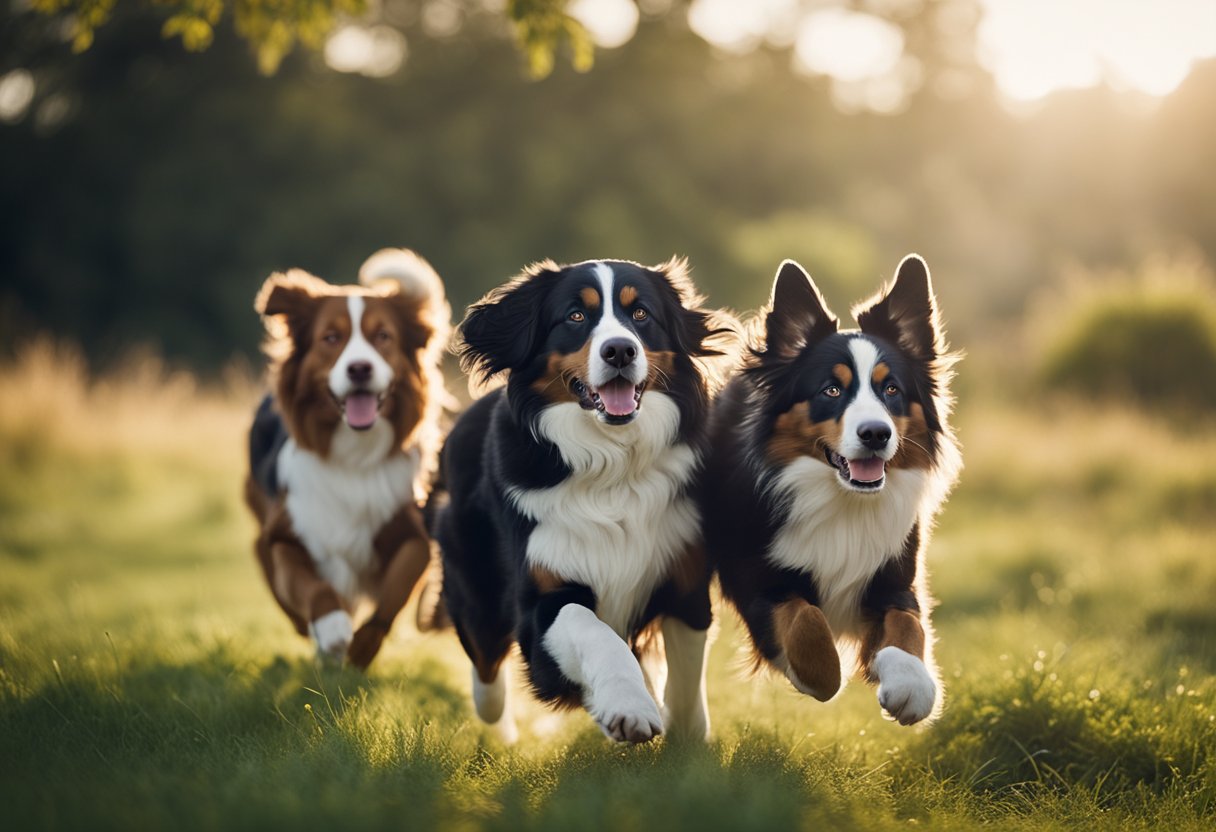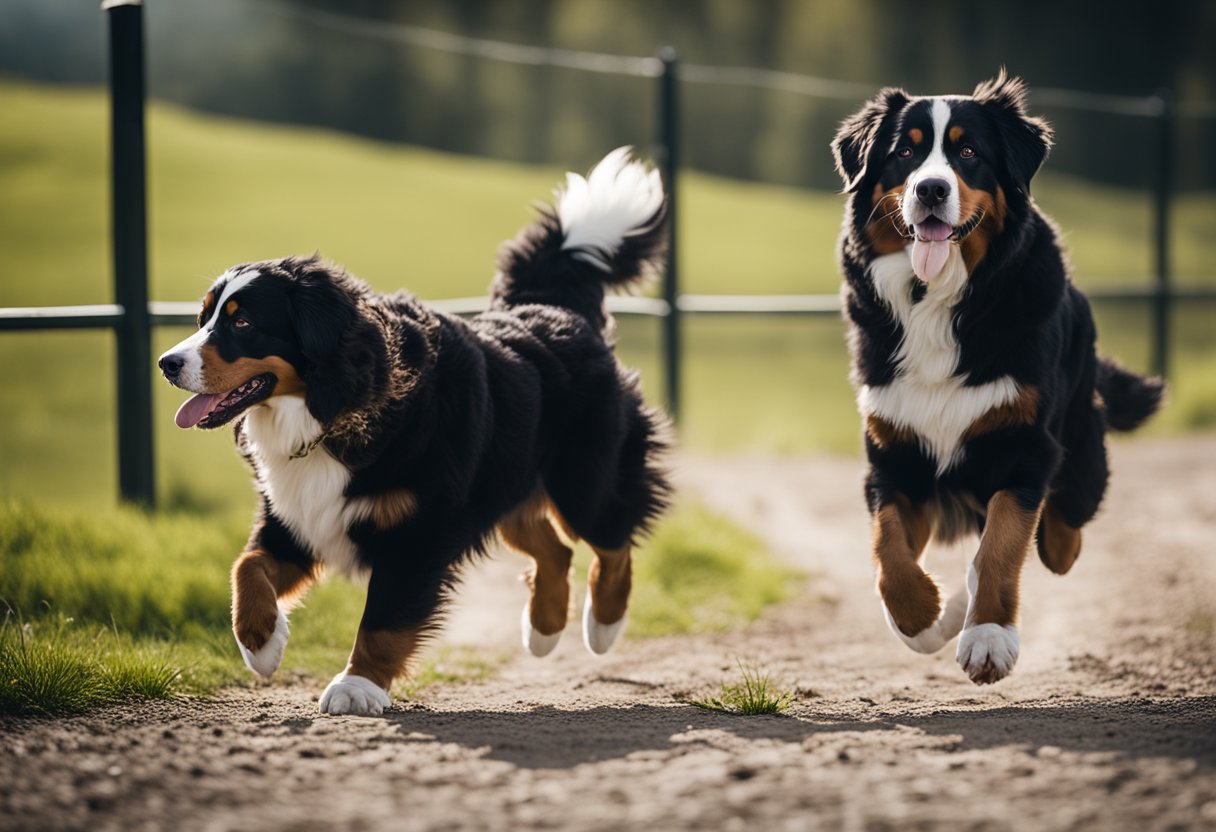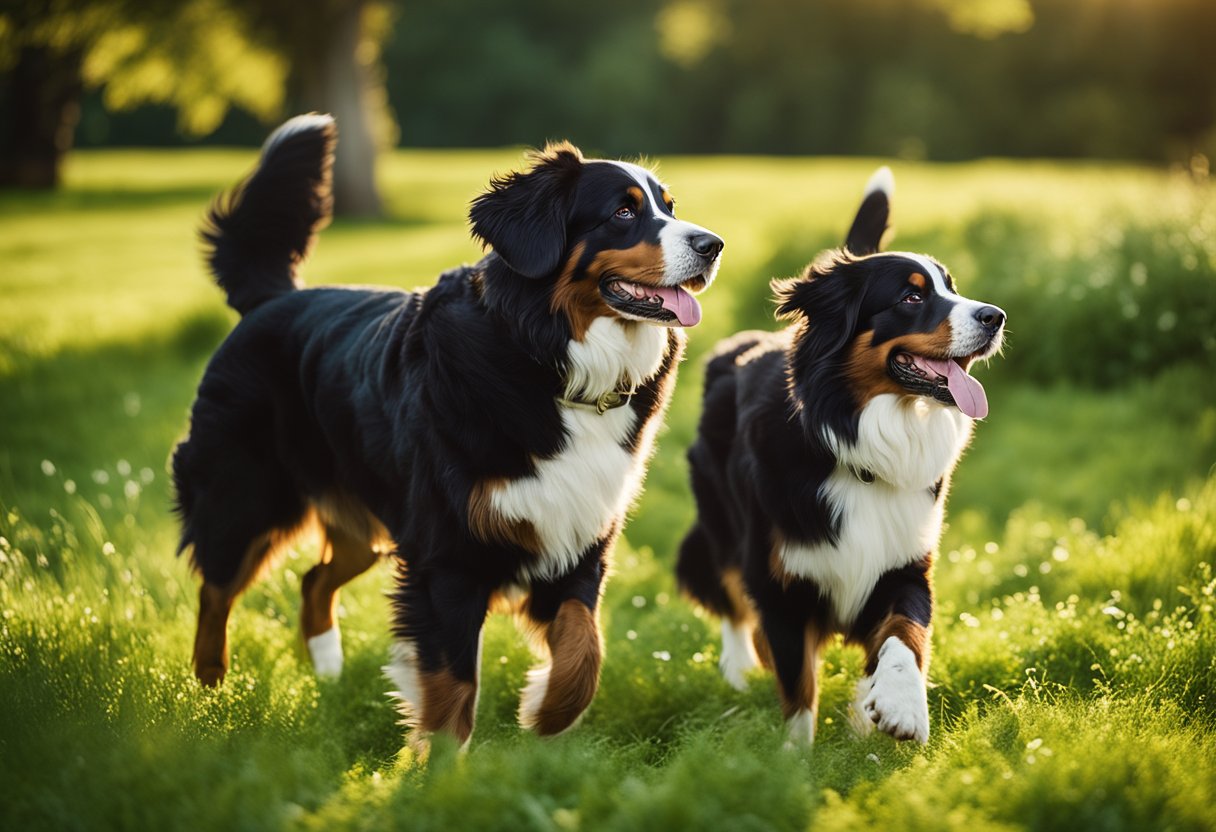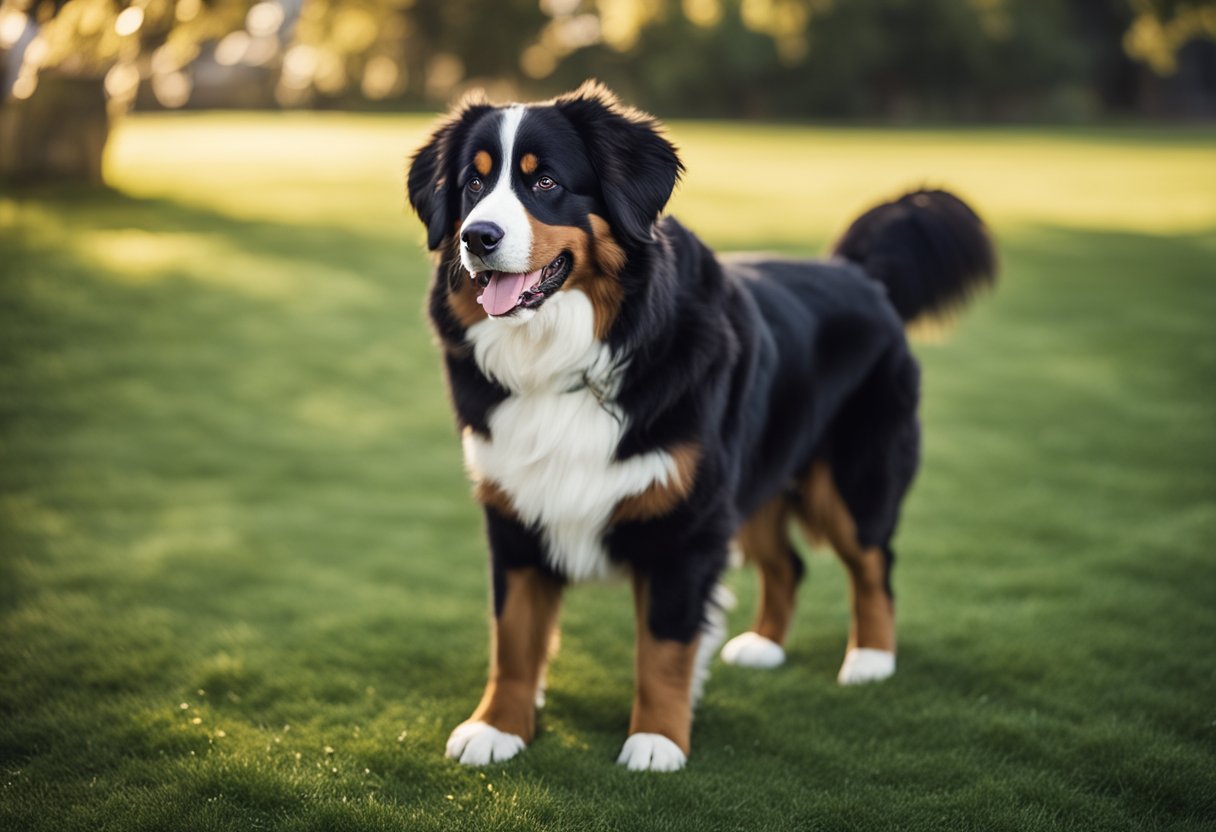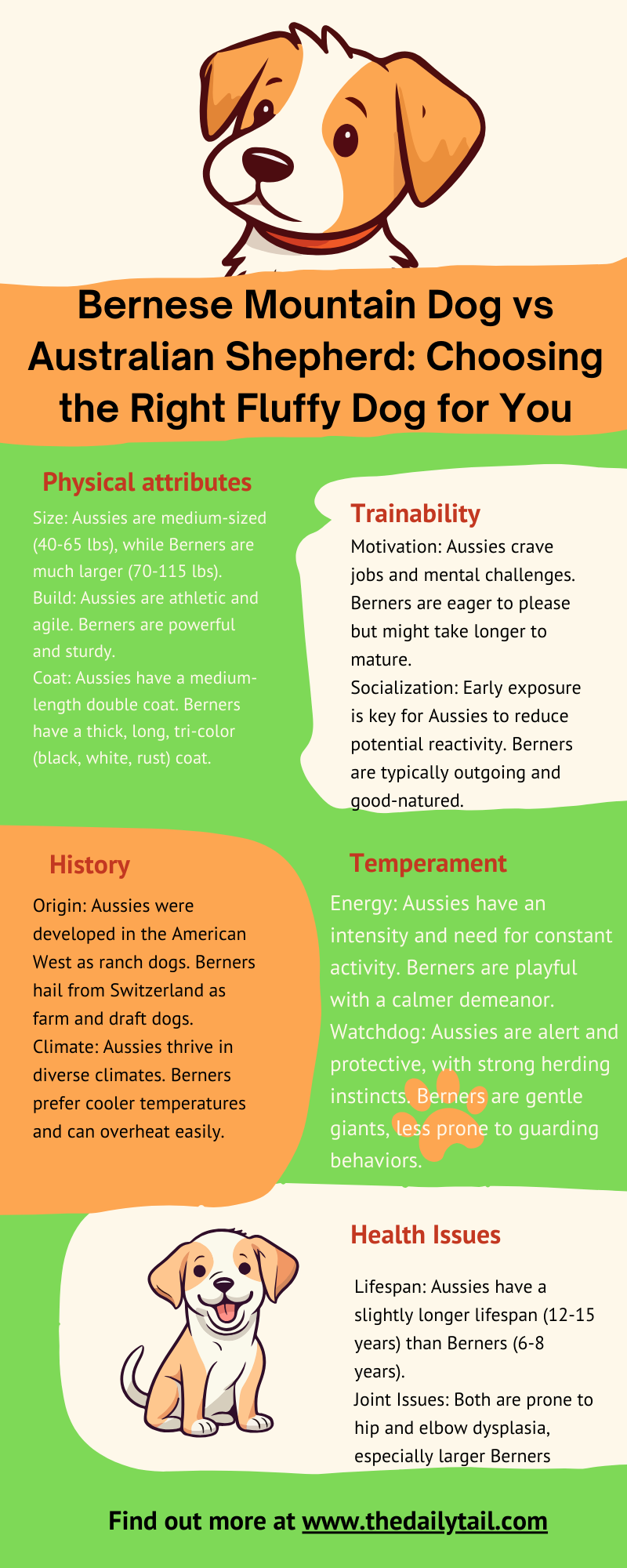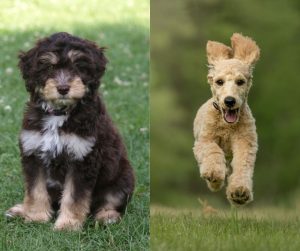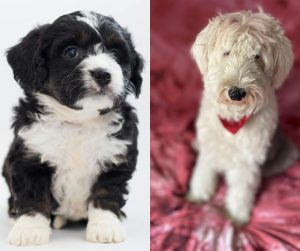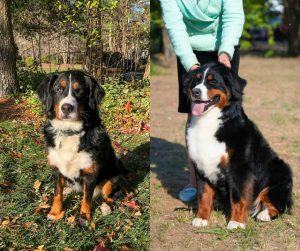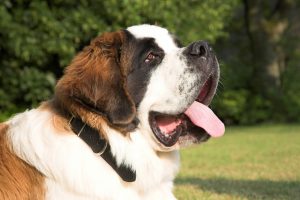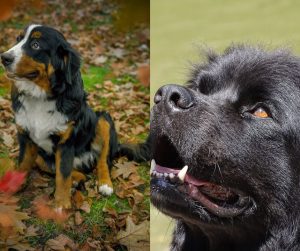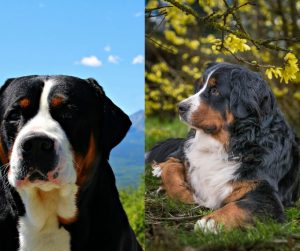When considering a new canine companion, prospective pet owners are often drawn to the charm and characteristics of breeds like the Bernese Mountain Dog and the Australian Shepherd. The Bernese Mountain Dog, with its origins as a farm dog in the Swiss mountains, is renowned for its sturdy build, affectionate nature, and striking tri-colored coat. These dogs are sizable, typically ranging from 25 to 28 inches in height and weighing a substantial 75 to 115 pounds.
Known for a friendly and social temperament, they’re revered as gentle giants, though their health status is regrettably a bit below average, with a shorter lifespan of 6 to 8 years.
In contrast, the Australian Shepherd is a smaller but highly energetic breed originally bred for herding livestock. While they might share the Bernese Mountain Dog’s social and friendly nature, they diverge in size, usually standing between 18 to 23 inches tall and weighing between 40 to 65 pounds.
With an above-average health rating, they often enjoy a lifespan of 13 to 15 years. This breed’s high energy and intelligent demeanor make them equally admirable, with a notable eagerness to please and trainability that appeals to active families or individuals looking for a dynamic pet.
The choice between a Bernese Mountain Dog and an Australian Shepherd may come down to factors such as living space, lifestyle, and the potential owner’s ability to meet the breed’s needs. Each breed presents unique attributes and challenges, from the Bernese’s larger size and extensive grooming requirements to the Australian Shepherd’s demand for extensive daily exercise and mental engagement.
These disparities underscore the importance of informed decision-making when selecting the right breed for a harmonious human-canine relationship.
Choosing between an Aussie and a Bernese Mountain Dog is as different as picking a trail run or a nap… with a furry companion! A lifetime of dog experience can’t prepare you for this decision. My decades with dogs have taught me one thing: size isn’t everything! Let’s compare the compact powerhouse Aussie to the lovable Bernese Mountain Dog.
Today, we will look at the Bernese Mountain Dog vs Australian Shepherd dog breed comparison. Let’s go.
Origins and History
The distinct backgrounds of the Bernese Mountain Dog and the Australian Shepherd heighten the appreciation for their unique traits. The former hails from the cold mountains of Switzerland, while the latter’s past weaves through the American West despite its name.
Origin of the Bernese Mountain Dog
Switzerland is the cradle of the Bernese Mountain Dog’s lineage. These sturdy canines were originally bred as farm dogs in the Swiss Alps, specifically in the canton of Berne. Their historical role included pulling carts, herding livestock, and serving as loyal companions to the farmers and dairymen of the region. This working heritage is encapsulated in their robust frame and amiable temperament.
First known import to the United States: A farmer named Isaac Schliess was reported to have brought the breed to American soil in 1926 aiming for recognition by the American Kennel Club (AKC).
Origin of the Australian Shepherd
Despite its misleading name, the Australian Shepherd’s genesis is deeply rooted in the ranches of the Western United States. These agile and intelligent dogs are the product of a rich ranching culture, bred for their exceptional herding abilities and adaptability. There are many theories about their lineage, but one fact remains clear: Australian Shepherds were refined in the U.S. to work with varied livestock, an aspect that shaped their development into the versatile dogs they are today.
Note: While their exact early history is surrounded by some mystery, their antecedents likely include herding dogs imported with flocks of sheep from Australia during the late 19th and early 20th centuries.
Bernese Mountain Dog vs Australian Shepherd Physical Characteristics
When comparing the Bernese Mountain Dog and the Australian Shepherd, several distinctive physical attributes are noted. They differ significantly in size, coat, and other distinctive features, which are essential for potential owners to consider.Size Comparison
The Bernese Mountain Dog is generally larger than the Australian Shepherd. This large dog breed stands between 25-28 inches in height and scales at a weight of approximately 70-115 pounds. On the other side, the Australian Shepherd has a height range of 18-23 inches and a weight that falls between 40-65 pounds.
Coat and Color
Coat: The Bernese Mountain Dog possesses a long, silky, and thick double coat, which requires frequent grooming due to its tendency to shed. The Australian Shepherd also has a double coat, but it is of medium length and slightly less demanding in terms of grooming.
Color: Both breeds display a variety of colors. The Bernese Mountain Dog typically showcases a tri-color coat consisting of black, white, and rust. The Australian Shepherd’s coat comes in a range of colors including blue merle, red merle, black, and red, often with white and/or tan markings.
Distinctive Features
The Bernese Mountain Dog has distinctive features that include a solid, muscular build with a gentle, affectionate demeanor. They often possess a strong, sturdy appearance that reflects their origin as a working dog. The Australian Shepherd is known for their agility and often has bright, expressive eyes that can be blue, brown, or amber. They have a more streamlined build than the Bernese, indicative of their herding lineage.
Personality and Temperament
When comparing the personalities and temperaments of Bernese Mountain Dog vs Australian Shepherd dog breed, one needs to recognize their distinct behavioral characteristics, which are a combination of energy levels, loyalty, intelligence, and affection.
Temperament of Bernese Mountain Dogs
Bernese Mountain Dogs are known for their affectionate nature and calm demeanor. They exhibit a high level of loyalty to their families, often forming strong bonds with their owners. These dogs tend to be friendly and sociable, not only with their human family but also with strangers, although they might initially be aloof until they become familiar. As for energy levels, they are quite active and enjoy being involved in family activities, but they also have a calmness that makes them great companions for quiet times.
- Energy Level: Active but balanced with calm periods
- Temperament: Friendly, loyal, sometimes aloof but warm up quickly
- Intelligence: Intelligent and capable of learning various tasks
Temperament of Australian Shepherds
Australian Shepherds, on the other hand, are highly energetic and require a good deal of exercise to remain content. They are intelligent workers who thrive on mental and physical stimulation. Known for their friendliness, they are typically not aloof and are quick to engage with both familiar people and newcomers. These dogs are very affectionate with their families and exhibit a great deal of loyalty. Their high-energy nature means they are always ready for playtime, work, or exercise, making them less calm than Bernese Mountain Dogs.
- Energy Level: High, with a need for regular stimulation
- Temperament: Extremely friendly, affectionate, and loyal
- Intelligence: Very intelligent with a high capacity for learning and work
Exercise and Activity Levels
Both the Bernese Mountain Dog and the Australian Shepherd are breeds with high energy levels that require regular exercise. Their needs stem from their historical roles as working dogs, which have instilled a natural inclination for activity and mental stimulation.
Exercise Needs of Bernese Mountain Dogs
Bernese Mountain Dogs are sturdy, large breed dogs known for their history as working dogs in the Swiss Alps. They require at least one hour of exercise daily to maintain their health and prevent boredom. Their activity routine should ideally include:
- Walking: Moderate-paced walks, preferably twice a day
- Playtime: Interactive games such as tug-of-war or fetch
- Running: Short bursts of running or free play in a secured area
Bernese Mountain Dogs benefit from tasks that offer both physical and mental challenges, akin to their traditional herding and draft work. Activities like pulling a cart or advanced obedience training can provide needed mental stimulation.
Exercise Needs of Australian Shepherds
Australian Shepherds are a herding breed, inherently active and energetic, and typically require more than two hours of exercise per day. An Australian Shepherd’s exercise regimen should incorporate:
- Running: Daily jogs or runs to match their high stamina
- Herding: Participating in herding activities, if possible, which cater to their instinctual behavior
- Agility Training: Engaging in dog sports like agility, obedience, or flyball provides both physical exercise and mental engagement
Due to their intelligence and eagerness to please, Australian Shepherds thrive on interactive and challenging activities that stimulate their minds as well as exercise their bodies.
Training and Intelligence
Both the Bernese Mountain Dog and the Australian Shepherd are recognized for their intelligence and trainability. These breeds exhibit a strong ability to learn commands and are generally eager to please, which can make dog training a rewarding endeavor.
Trainability of Bernese Mountain Dogs
The Bernese Mountain Dog is known for its intelligence, often making it a receptive student in training scenarios. They are capable of learning a wide range of commands and generally respond well to positive reinforcement techniques. Because of their size and strength, early training to instill obedience is particularly important. It’s beneficial to maintain a consistent training schedule and use a variety of exercises to keep their attention. As they are eager to please, they tend to respond well to training, provided it’s conducted with patience and positive affirmation.
Trainability of Australian Shepherds
Australian Shepherds are highly intelligent and renowned for their trainability. This breed’s smart and work-oriented nature makes them excellent at learning commands quickly. They are known for their focused attention and are often very eager to please their trainers, which bodes well for training regimens. Regular mental and physical stimulation is crucial to keep an Australian Shepherd engaged, and their intelligence allows for more advanced training. Consistency and variety in their training can help harness their intelligence positively and avoid boredom or inattention.
Health and Lifespan
When comparing the health and lifespan of Bernese Mountain Dogs and Australian Shepherds, it is observed that Australian Shepherds tend to have a longer lifespan, averaging between 12 and 15 years, while Bernese Mountain Dogs generally have a shorter lifespan of 6 to 9 years. The health conditions that affect these breeds can vary significantly due to their different genetic backgrounds.
Common Health Issues in Bernese Mountain Dogs
Bernese Mountain Dogs may experience several genetic health conditions, one of which includes hip and elbow dysplasia, conditions that can lead to pain and mobility issues. They are also prone to certain types of cancer, which is a significant factor in their typically shorter lifespan. Other health concerns for this breed include progressive retinal atrophy, which affects vision, and von Willebrand’s disease, a blood clotting disorder. These health issues should be carefully considered as they can affect the dog’s overall quality of life.
Common Health Issues in Australian Shepherds
Australian Shepherds are known to be susceptible to hip dysplasia, much like the Bernese Mountain Dogs, although the incidence may vary. They also have potential hereditary conditions such as epilepsy and progressive retinal atrophy. Another condition to be aware of is collie eye anomaly, which can lead to vision impairment or blindness. Like many breeds, they can also suffer from hypothyroidism and obesity, which are often manageable with proper care and diet. It is important for prospective dog owners to be aware of these conditions and seek responsible breeders who perform health screenings.
Grooming and Care
Both the Bernese Mountain Dog and the Australian Shepherd possess thick coats that require regular grooming attention. They shed throughout the year and have specific grooming needs, especially during shedding seasons.
Grooming Needs of Bernese Mountain Dogs
The Bernese Mountain Dog has a long, thick coat that can trap dirt and debris, necessitating routine grooming. Shedding is significant, particularly during the fall and spring. To keep their coat in good condition, they should be brushed a few times a week, with daily brushing recommended during peak shedding seasons. Dog owners should also be mindful of drooling, as this breed can drool quite a bit.
- Brushing Frequency: At least two to three times per week
- Shedding: Heavy shedding, especially during seasonal changes
- Drooling: Moderate to high
Grooming Needs of Australian Shepherds
Australian Shepherds have a moderately long fur that is dense and may shed heavily. Although they don’t typically drool like the Bernese, their coat requires consistent grooming to minimize shedding and prevent matting. They benefit from weekly brushing, and possibly more during their shedding seasons, to maintain the health and appearance of their fur.
- Brushing Frequency: Weekly, more often during shedding seasons
- Shedding: Moderate to heavy
- Drooling: Low
Breed-Specific Behavior
In comparing the Bernese Mountain Dog and the Australian Shepherd, it is essential to understand the behavioral traits specific to each breed. These traits have been honed through their historical roles as working dogs involved in herding, guarding, and managing livestock.Behavior of Bernese Mountain Dogs
Herding and Guarding: Bernese Mountain Dogs possess a calm and easygoing temperament, doing well with families as they tend to be affectionate and loyal. Their demeanor has been shaped by their origin as farm dogs in the Swiss mountains, where they were used for pulling carts, herding cattle, and serving as watchful guardians.
- Interaction with Families: They tend to have a gentle approach to children and usually integrate well into the family unit
- Barking: While not overly aggressive, they can be protective of their territory and may bark to alert their owners of anything unusual
- Destructive Behavior: Without adequate mental and physical stimulation, they may exhibit destructive behaviors
Behavior of Australian Shepherds
Herding and Activity Level: Australian Shepherds exhibit high energy levels that reflect their breeding as herding dogs. They thrive on having a job to do and excel in managing livestock due to their intelligence and work-oriented nature.
- Interaction and Exercise: Known to be interactive with their human companions, they require sufficient daily exercise to prevent frustration and destructive behavior, often needing tasks that challenge them both physically and mentally
- Barking: As with many herding breeds, Australian Shepherds may have a tendency to bark, especially when trying to control cattle or being alert to their environment
- Aggression: While not typically aggressive, without proper socialization, they can be wary of strangers, which may lead to defensive behaviors
Compatibility with Families
When considering a family dog, it’s important to assess how a breed interacts with children and integrates into the familial environment. Both the Bernese Mountain Dog and the Australian Shepherd are known for their companionable natures, but they have distinct traits that affect their compatibility with families.
Bernese Mountain Dogs with Families
Bernese Mountain Dogs are known for their affectionate and friendly demeanor, making them excellent family dogs. They typically display a gentle nature which is well-suited for families with children. However, due to their large size, supervision is recommended when they are around small children to prevent accidental knocking over during play. These dogs are social creatures and often thrive in the family environment, forming strong bonds with family members.
- Child Interaction: Best with supervision
- Family Integration: Highly social, strong familial bonds
Bernese Mountain Dogs may be a tad reserved with strangers, but this does not usually extend to family members or familiar individuals. They also usually get along with other pets, including cats, provided they have been properly socialized.
Australian Shepherds with Families
Australian Shepherds are energetic and social, requiring an active family that can match their energy levels. Their intelligence and trainability make them a good fit for families, and they often excel in homes with older children who can engage with them through play and training.
- Child Interaction: Better with older children
- Family Integration: Eager participants in family activities
They possess a protective instinct and are loyal companions. Due to their herding background, Australian Shepherds may try to herd children and pets. They usually do well with other pets, but their interaction with smaller pets, like cats, should be monitored to ensure it is positive.
Both breeds can make wonderful family dogs when matched with the right family dynamic and when their needs for social interaction, exercise, and companionship are met.
Breed Popularity and Recognition
Both Bernese Mountain Dogs and Australian Shepherds are well-known breeds recognized by prominent kennel clubs. Their popularity is due in part to their distinctive characteristics and versatile abilities.
Bernese Mountain Dog Recognition
American Kennel Club (AKC) ranking: Bernese Mountain Dogs are ranked within the top 50 most popular breeds by the AKC. Their impressive size, gentle temperament, and tri-color coat make them easily recognizable.
- Breed clubs and organizations:
- Bernese Mountain Dog Club of America (BMDCA)
- International Bernese Mountain Dog Federation (IBF)
Australian Shepherd Recognition
American Kennel Club ranking: Australian Shepherds often rank in the AKC’s top 20 most popular breeds. They are valued for their intelligence, agility, and medium size, which suits various households.
- Breed clubs and organizations:
- United States Australian Shepherd Association (USASA)
- Australian Shepherd Club of America (ASCA)
Both breeds are well-regarded not only for companionship but also for their capacity to perform in work and competitive environments.
Lifestyle Compatibility of Australian Shepherds
Australian Shepherds are adaptable dogs that can thrive in both cities and countryside settings, provided they have enough exercise and mental stimulation. They possess high intelligence and energy and require at least 1-2 hours of exercise per day to prevent boredom and destructive behavior. Even though they are medium-sized and less demanding on indoor space compared to Bernese Mountain Dogs, they still benefit from a yard. Their herding instinct and strength should be channeled through activities, and they can manage well with owners who enjoy an active lifestyle or have livestock.
Exercise Needs:
- Minimum: 1-2 hours per day
- Better with access to outdoor space for activities
Living Space:
- Can adapt to smaller spaces if sufficiently exercised
- A yard is a bonus but not a requirement
Lifestyle:
- Suitable for various living situations, including cities
- Complements an active lifestyle with regular outdoor time
Final Words
When making a decision between the Australian Shepherd and the Bernese Mountain Dog, prospective owners should consider the differences and similarities of these breeds to ensure the right fit for their lifestyle.Final Thoughts on Choosing the Right Breed
The choice between an Australian Shepherd and a Bernese Mountain Dog hinges on understanding each breed’s unique characteristics. Australian Shepherds are generally smaller, highly energetic, and require substantial mental and physical stimulation. They thrive in active environments and are known for their agility and intelligence.
On the other hand, the Bernese Mountain Dog is larger, with a more majestic presence and a calm demeanor. They are affectionate, family-oriented pets that need space to roam and a cooler climate to stay comfortable.
Both breeds share a history of being working dog breeds, which equates to high levels of intelligence and trainability. They also make great companions, with a proven track record of fitting well into family life. The decision to choose between the two should weigh their respective exercise needs, grooming requirements, and adaptability to family life. It’s imperative to assess these factors in relation to one’s personal living situation and activity level.

